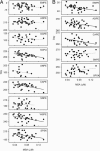Antarctic birds breed later in response to climate change
- PMID: 16601100
- PMCID: PMC1458863
- DOI: 10.1073/pnas.0510397103
Antarctic birds breed later in response to climate change
Abstract
In the northern hemisphere, there is compelling evidence for climate-related advances of spring events, but no such long-term biological time series exist for the southern hemisphere. We have studied a unique data set of dates of first arrival and laying of first eggs over a 55-year period for the entire community of Antarctic seabirds in East Antarctica. The records over this long period show a general unexpected tendency toward later arrival and laying, an inverse trend to those observed in the northern hemisphere. Overall, species now arrive at their colonies 9.1 days later, on average, and lay eggs an average of 2.1 days later than in the early 1950s. Furthermore, these delays are linked to a decrease in sea ice extent that has occurred in eastern Antarctica, which underlies the contrasted effects of global climate change on species in Antarctica.
Conflict of interest statement
Conflict of interest statement: No conflicts declared.
Figures




References
-
- Beebee T. J. C. Nature. 1995;374:219–220.
-
- Crick H. Q. P., Dudley C., Glue D. E., Thomson D. L. Nature. 1997;388:526.
-
- Walther G. R., Post E., Convey P., Menzel A., Parmesan C., Beebee T. J. C., Fremont J.-M., Hoegh-Guldberg O., Bairlein F. Nature. 2002;416:389–395. - PubMed
-
- Parmesan C., Yohe G. Nature. 2003;421:37–42. - PubMed
-
- Root T. L., Price J. T., Hall K. R., Schneider S. H., Rosenzweig C., Pounds A. J. Nature. 2003;421:57–60. - PubMed
Publication types
MeSH terms
LinkOut - more resources
Full Text Sources
Other Literature Sources

